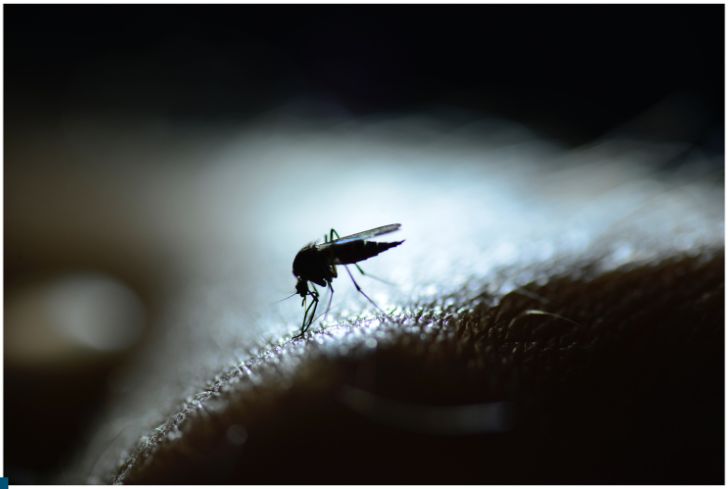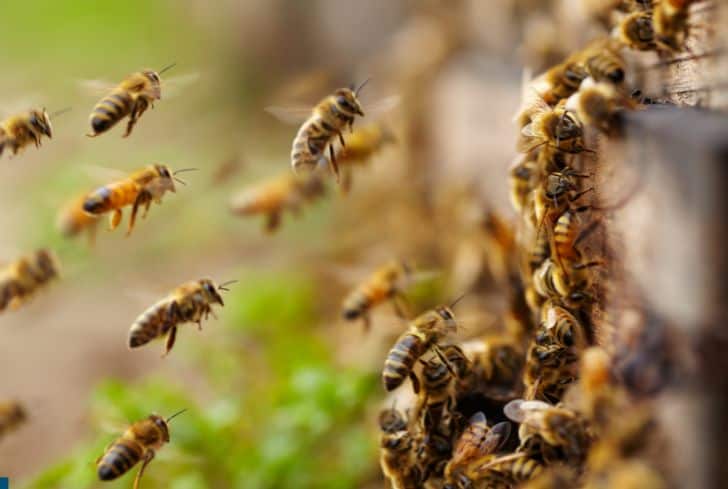How High, Far and Fast Can Mosquitoes Fly? (Answered)

A particular sound that mosquitoes make can irritate you very quickly. Remember how painful it was to hit yourself as you swatted it away? But why do they appear to enjoy biting your legs the most? Can’t they fly higher? How high can mosquitoes fly, by the way?
We’ve received that question frequently, so we have decided to address it in this article. Learn how far, how fast, and how high different mosquito species can fly. You’ll also discover which mosquito species are capable of traveling quite far from their breeding grounds and how far mosquitoes can smell.
How High Can a Mosquito Fly?
Most mosquito species that bite human beings generally don’t fly above 25 feet from the ground. They stay close to their breeding areas when flying. Others will fly higher as they search for food or attempt to reproduce on taller trees or structures. They can fly higher thanks to the wind. Instead of flying, other mosquito species will “hitch” rides. They can ride on equipment and create new breeding grounds in favorable conditions.
It’s not only the breeding ground that will make mosquitoes fly higher, but the environment will also matter. After all, you will find some mosquito species 8000+ feet above sea level in the Himalayas. And some in high latitude winds 950 feet up. Most mosquito species prefer lower altitudes as they are warmer than high altitude areas.
How Far Can Mosquitoes Travel?
Most mosquito species prefer not to travel far from their breeding places. Some will travel between 1 to 3 miles from their breeding grounds, while others travel 7 miles. Others like the saltmarsh species can travel up to 40 miles from their breeding grounds. Their preference to travel shorter distances does not mean they can’t travel long distances.
Mosquitoes can travel great distances in search of food or favorable conditions. However, most species would rather stay close to their breeding grounds than travel long distances.
How Fast Can Mosquitoes Fly?
Depending on the species, a mosquito can fly at a maximum speed of 1 to 1.5 miles per hour in still air. While you might not think it is not swift, remember that it is fast enough to avoid your swatting hand. A mosquito’s species and sex will determine how fast it can fly. Although mosquitoes fly more slowly than certain other flying insects, like bees, they can still outrun their predators.
Most people assume mosquitoes are fast due to how fast they seem to flap their wings. In a single second, mosquitoes can flap their wings up to 800 times per second. But if they can flap their wings that quickly, why can’t they fly even faster? A study by John Hopkins university shows mosquitoes flap their wings to produce sounds to attract a potential mate.
How High Can a Dengue Mosquito Fly?
The dengue mosquito can fly up to 50+ feet above the ground. That’s why they are likely to be found on the seventh or the tenth floor. The dengue mosquito can fly up to 400 meters in search of a container with one inch of water or another convenient location for breeding. However, they prefer to stay close to their primary food source, human blood. A female mosquito from the Aedes genus is the primary carrier of Dengue fever.
Here are a few more additional factors about the dengue mosquito:
- The dengue mosquito prefers to lay its eggs close to human habitation in the walls of a water-filled container.
- The dengue mosquito can travel hundreds of yards while searching for vessels holding water. However, it does not lay its eggs in wetlands, lakes, rivers, canals, drainages, or ditches.
- The female dengue mosquito can lay up to five times her lifetime’s worth of eggs, which hatch when placed in water.
- Only the female dengue mosquitoes bite humans.
How High Can a Malaria Mosquito Fly?
Some studies show malaria mosquitoes can soar up to 290 meters above the ground. The winds in the Sahara’s semi-deserts allow them to fly that high. Scientists conducted a study in four villages between 2013 and 2015, demonstrating that anopheles, the mosquito that transmits malaria, can fly up to 290 meters above the ground.
The malaria mosquito can travel great distances and perhaps spread the malaria disease. It can fly that high by riding high-altitude winds. By doing so, they can move hundreds of kilometers and continue to breed in their new territory.

How High Can The Aedes Mosquito Fly?
The Aedes mosquito only flies about 400 feet from its breeding ground. Aedes aegypti and Aedes albopictus are the mosquito species responsible for the Zika virus spread. Even though the Aedes mosquito can’t fly very high, it can cover much ground. They easily board ships, planes, and carry-on luggage. They can complete their entire life cycle once they locate a small vessel with some water.
Aedes aegypti
The famous “yellow fever mosquito,” scientific name, is the Aedes aegypti. The yellow fever mosquito doesn’t fly more than one hundred yards from its breeding ground and stays close to it. Yellow and dengue fever are the diseases the mosquito primarily spreads in parts of South, Central, and North America.
Although it appears similar to other species, its legs have white bands. The thorax area of the adult aegypti is covered in white scales and has a black body overall. They lay their eggs in any container with enough water, where they can survive for a year.
Although the yellow fever mosquito prefers to bite in the morning or late afternoon, it may also attack at night with enough artificial lighting. It primarily bites your ankles and prefers human blood. The females will transmit the two diseases.
Aedes albopictus
The “Asian tiger mosquito” is another name for Aedes albopictus. It is a potential carrier of yellow fever, encephalitis, and heartworm in pets, as well as a carrier of dengue fever. The Asian Tiger Mosquito remains within a half-mile radius of its breeding grounds.
The body of the Asian tiger mosquito is black with a single white stripe and numerous white stripes on the legs. The antennae of the mosquito are smaller than its legs. The Asian tiger mosquito will lay its eggs in any container if it can hold small amounts of water.
The ability of the Asian tiger mosquito to survive in a variety of conditions, as opposed to the yellow fever mosquito, which can only survive in tropical climates, is one of its unique features. A female tiger mosquito bites very painfully during the daytime. She can bite you numerous times and is quite persistent and aggressive.
Can Mosquitoes Fly To High Floors?
Mosquitos can indeed fly to higher floors. Some mosquito species can fly up to the 20th-story apartments and even higher. Even a small number of mosquitoes can keep you from sleeping soundly. They will create a breeding ground in your flat if they can find a comfortable environment, and you will soon be dealing with a severe infestation.
Mosquitoes usually fly on higher floors along the frames of the building to avoid resistance from the wind. Additionally, they will use interior passageways like elevators, trash chutes, vents, and closed-off spaces. Because mosquitoes can hitch rides, they can use your luggage, other equipment, or even potted plants to get to the high floors.
What Mosquito Species Fly Farther Away From Their Breeding Grounds?
Mosquitoes can travel up to 50 kilometers, depending on their species. However, most species won’t travel far from their breeding grounds. Some mosquito species that travel far from their breeding grounds include:
- Culex annulirostris: Culex is known as the common banded mosquito. They can travel between 5-10 km from their breeding ground. The culex resides in Indonesia, Fiji, Australia, and the Philippines.
- Psorophora mosquitoes: These species have giant mosquitoes residing in the continental United States. They can travel up to 4.2 km, searching for a large mammal to feed on. It mainly favors tropical or temperate environments.
- Culiseta: Culiseta mosquitoes reside in most parts of the world apart from South America. They have no problem flying up to 5km from their breeding ground in search of food. The Culex mainly feed on birds, mammals, and occasionally reptiles.
- Aedes sollicitans: Also known as the Eastern saltmarsh. It can travel up to 64 km in search of a blood meal. The mosquito resides along the Atlantic coast from Northeastern Canada south to Florida and down the gulf of Mexico to Texas.
How Far Can Mosquitoes Smell?
Did you know that mosquitoes locate you by smelling you? If you are not more than 165 feet away from them, mosquitoes can detect your scent. Before using their eyes, female mosquitoes use their sense of smell to choose their target. Once they smell you, they will follow the scent of your body until they can see you before launching their attack.
The nerve cells known as cpA neurons in female mosquitoes have carbon dioxide receptors. However, mosquitoes are still attracted to the smell of human skin even without carbon dioxide. The same receptors that detect carbon dioxide can also detect human skin odor.
Here is a video from the National Institute of Allergy and Infectious Diseases (NIAID) that clearly explains how mosquitoes use their sense of smell to find and bite you.
Mosquitoes can find you by smelling your sweat. Ammonia and lactic acid from your sweat are compounds that attract mosquitoes. Even though it may seem mild to you, the smell of ammonia alone will let mosquitoes know you’re nearby.
Conclusion
While most mosquitoes prefer not to fly too high or travel too far from their breeding grounds, others have no problem going further away. Some mosquitoes, such as the Easter saltmarsh mosquito, have been reported to fly over 40 miles. That explains how mosquitoes can migrate between regions and establish new breeding grounds.

